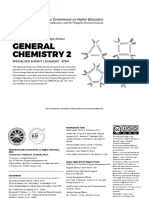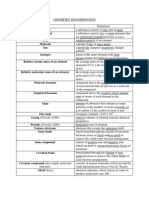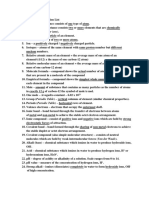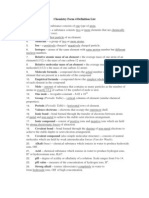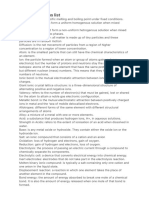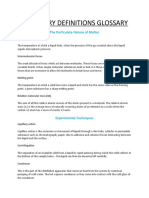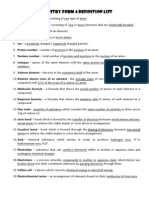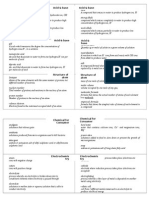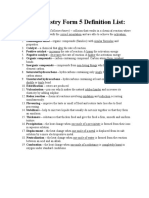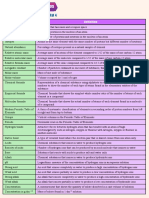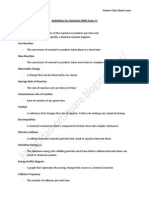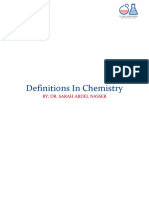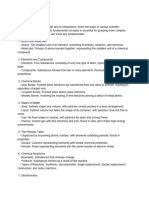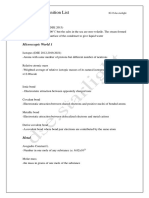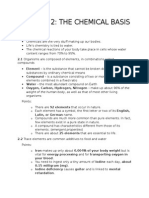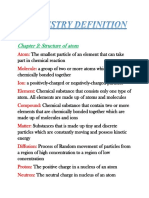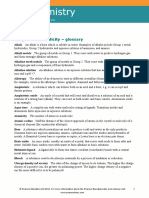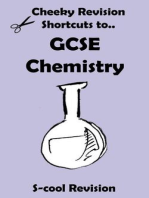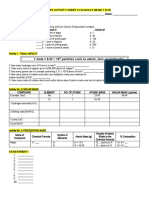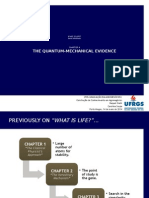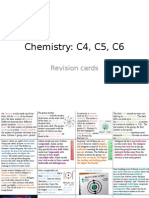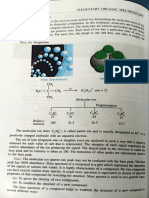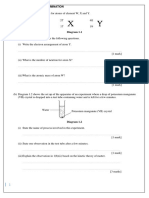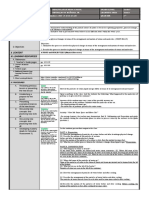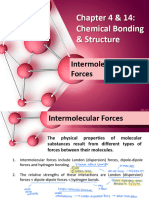Chemistry Form 4 Definition List
Chemistry Form 4 Definition List
Uploaded by
Syazana Mohd RosliCopyright:
Available Formats
Chemistry Form 4 Definition List
Chemistry Form 4 Definition List
Uploaded by
Syazana Mohd RosliCopyright
Available Formats
Share this document
Did you find this document useful?
Is this content inappropriate?
Copyright:
Available Formats
Chemistry Form 4 Definition List
Chemistry Form 4 Definition List
Uploaded by
Syazana Mohd RosliCopyright:
Available Formats
Chemistry Form 4 Definition List 1. 2. 3. 4. 5. 6. 7. 8. 9. 10. 11. 12. 13. 14. 15. 16. 17. 18. 19. 20.
21. 22. 23. 24. Element a substance consists of one type of atom. Compound a substance consists two or more elements that are chemically bonded (molecule or ions). Atom smallest particle of an element. Molecule a group of two or more atoms. Ion a positively charged / negatively charged particle. Isotopes atoms of the same element with same proton number but different nucleon numbers. Relative atomic mass of an element = the average mass of one atom of an element/ ((1/12) x the mass of one carbon-12 atom) Relative molecular mass of an element = the average mass of one atom of an molecule/ ((1/12) x the mass of one carbon-12 atom) Molecule formula compound shows the actual number of atoms of each element that are present in a molecule of the compound Empirical formula compound shows the simplest whole number ratio of atoms of each element in the compound Mole amount of substance that contains as many particles as the number of atoms inexactly 12 g of carbon-12 the symbol of mole is mol. One mole Avogadro constant 6.02 x 1023 Group (Periodic Table) vertical columns of element (similar chemical properties). Periods (Periodic Table) horizontal rows of element. Valence electrons electrons that occupy the outermost shell. Ionic bond bond formed through the transfer of electrons between atoms of metal and non-metal to achieve the stable octet electron arrangement. Ionic compound consist of positive ions and negative ions which are held by strong electrostatic forces of attraction. Covalent bond bond formed through the sharing of non-metal electrons to achieve the stable duplet or octet electron arrangement. Covalent compound (also simple molecular structure) consists of neutral molecules which are held by weak intermolecular forces (Van der Waals). Alkali (base) chemical substance which ionizes in water to produce hydroxide ions, OH -. Acid chemical substance which ionizes in water to produce hydrogen ions, H + or hydroxonium ions, H3O+. pH degree of acidity or alkalinity of a solution. Scale ranges from 0 to 14. pH value measure of the concentration of hydrogen ions, H+. Strong alkali ionises (dissociates) completely in water to form hydroxide ions, OH- of high concentration.
25. 26. 27. 28.
Weak alkali ionises (dissociates) partially in water to form hydroxide ions, OH- of low concentration. Strong acid ionises (dissociates) completely in water to form hydrogen ions, H+ of high concentration. Weak acid ionises (dissociates) partially in water to form hydrogen ions, H+ of low concentration. Polymer long chain molecules made up by monomer (repeating unit).
SPM Chemistry Form 5 Definition List: 1. 2. 3. 4. 5. 6. 7. 8. 9. 10. 11. 12. 13. 14. 15. 16. 17. Effective collision (Collision theory) collision that results in a chemical reaction where the particles collide with the correct orientation and are able to achieve the activation energy. Homologous series organic compounds (families) with similar formulae and properties. Catalyst a chemical that alter the rate of reaction. Positive catalyst increases the rate of reaction & lower the activation energy. Negative catalyst decreases the rate of reaction & higher the activation energy Organic compounds carbon-containing compound. Carbon atoms form covalent bonds. Inorganic compounds compounds from non-living things which do not contain the element carbon. Saturated hydrocarbons hydrocarbons containing only single bonds between all carbon atoms. Unsaturated hydrocarbons hydrocarbons containing at least one carboncarbondouble or triple bond. Esterification esters are produced Vulcanisation process which makes the natural rubber harder and increases its elasticity by adding sulphur. Redox reaction chemical reactions involving oxidation and reduction occurring simultaneously. Flavouring improve the taste or smell of food and restore taste loss due to food processing. Stabilisers help to mix two liquids that usually do not mix together so that they form an emulsion. Thickeners substances that thicken food and give the food a firm, smooth and uniform texture. Precipitation the heat change when one mole of a precipitate is formed from their ions in aqueous solution. Displacement the heat change when one mole of a metal is displaced from its salt solution by a more electropositive metal.
18. 19.
Neutralisation the heat change when one mole of water is formed from the reaction between an acid and an alkali. Combustion the heat change when one mole of a substance is completely burnt in oxygen under standard conditions.
You might also like
- Nelson Science Perspectives 10Document616 pagesNelson Science Perspectives 10Nguyen Julia70% (83)
- General Chemistry 2 TGDocument596 pagesGeneral Chemistry 2 TGZenda Marie Facinal Sabinay88% (72)
- Chemistry SPM DefinitionsDocument3 pagesChemistry SPM DefinitionsUchiha Kimono88% (8)
- O LVL Chem Definitions ListDocument6 pagesO LVL Chem Definitions Listacsbr4science173% (11)
- IGCSE Chemistry DefinitionsDocument5 pagesIGCSE Chemistry Definitionsjenifer100% (3)
- Anatomy & Physiology (Chapter 2 - Chemical Basis of Life)Document16 pagesAnatomy & Physiology (Chapter 2 - Chemical Basis of Life)ANDREA GRAZILLE NAVAIRANo ratings yet
- As Chemistry Important Terms DefinitionsDocument3 pagesAs Chemistry Important Terms DefinitionsMuhammad MalikNo ratings yet
- SPM Chemistry Form 5 Definition ListDocument3 pagesSPM Chemistry Form 5 Definition ListNursafika Bahira100% (2)
- SPM Definition ListDocument3 pagesSPM Definition ListWong Weng SiongNo ratings yet
- Chemistry Form 4 Definition ListDocument3 pagesChemistry Form 4 Definition ListAliif IsmailNo ratings yet
- Chemistry Form 4Document3 pagesChemistry Form 4gitumbiiiamosNo ratings yet
- SPM Chemistry Definition ListDocument3 pagesSPM Chemistry Definition ListLooiNo ratings yet
- DefinitionsDocument6 pagesDefinitionsali ahsan khanNo ratings yet
- Marco Wong Definition List 2022DSE 2Document19 pagesMarco Wong Definition List 2022DSE 2styy.921No ratings yet
- Chemistry Form 4 Definition ListDocument2 pagesChemistry Form 4 Definition ListRabbitNo ratings yet
- Chemistry - BSN 1Document6 pagesChemistry - BSN 1Arianne Jen GenotivaNo ratings yet
- Chem Definitions ListDocument3 pagesChem Definitions ListWenran OngNo ratings yet
- Chemistry Definitions Glossary: The Particulate Nature of MatterDocument12 pagesChemistry Definitions Glossary: The Particulate Nature of MatterShahzaib AliNo ratings yet
- Form 4 Chemistry Definition ListDocument2 pagesForm 4 Chemistry Definition ListYixin HowNo ratings yet
- As Chemistry Definitions: Chapter 1: Atoms, Molecules and StoichemistryDocument6 pagesAs Chemistry Definitions: Chapter 1: Atoms, Molecules and StoichemistryRamanath RamNo ratings yet
- Chemistry Form 4 Definition ListDocument3 pagesChemistry Form 4 Definition ListElene Tan Kim LingNo ratings yet
- DefinitionsDocument4 pagesDefinitionsSimone GhiaNo ratings yet
- UntitledDocument8 pagesUntitledWaggle The GreatNo ratings yet
- Important DefinitionsDocument6 pagesImportant DefinitionsicedgoblinNo ratings yet
- Chemistry Glossary For A2Document21 pagesChemistry Glossary For A2s_s_i_hassaanNo ratings yet
- Alkali Strong Alkali Acid: Acid & Base Acid & BaseDocument5 pagesAlkali Strong Alkali Acid: Acid & Base Acid & BaseMohd HanisNo ratings yet
- Chem 1Document8 pagesChem 1nmaheshan4No ratings yet
- SPM Chemistry Form 5 Definition ListDocument1 pageSPM Chemistry Form 5 Definition ListAkira93No ratings yet
- Chemistry With Boos Form 4 and 5 DefinitionsDocument4 pagesChemistry With Boos Form 4 and 5 DefinitionsFARTIN ALIA NISRINA BINTI MOHD FARID0% (1)
- Definitions For Chemistry SPM F5Document8 pagesDefinitions For Chemistry SPM F5Yvonne Choo Shuen Lann100% (7)
- Grade 11 Chemistry DefinitionsDocument4 pagesGrade 11 Chemistry DefinitionsEnzo YeyeNo ratings yet
- Fred Redmore - ChemistryDocument12 pagesFred Redmore - ChemistryMark Anthony SantosNo ratings yet
- Definitions in ChemistryDocument8 pagesDefinitions in ChemistryJana AymanNo ratings yet
- REVIEWERDocument3 pagesREVIEWEREmelly PadillaNo ratings yet
- Chemistry Vocabulary - H. Bio. Web VersionDocument42 pagesChemistry Vocabulary - H. Bio. Web VersionAshrafNo ratings yet
- AP Bio CHDocument3 pagesAP Bio CHlinuspauling101No ratings yet
- Chemistry Unit 4 and 5 List of VocabularyDocument2 pagesChemistry Unit 4 and 5 List of Vocabularycondition123No ratings yet
- Y12 OCR A Level Chemistry KeywordsDocument4 pagesY12 OCR A Level Chemistry KeywordsNguyễn AnnaNo ratings yet
- Basic Terminology in ChemistryDocument4 pagesBasic Terminology in ChemistryHaider JalalNo ratings yet
- Chapter 2 - The Chemistry of LifeDocument23 pagesChapter 2 - The Chemistry of LifeDorothy AtilanoNo ratings yet
- Chemistry GSCE NotesDocument16 pagesChemistry GSCE NotesMariaNo ratings yet
- Chemistry NotesDocument2 pagesChemistry Notes123thegamestartsnowNo ratings yet
- AQA A Level Chemistry Unit 4 DefinitionsDocument1 pageAQA A Level Chemistry Unit 4 DefinitionsMuadh ChatiNo ratings yet
- 2 ChemistryDocument7 pages2 ChemistryAlexandra EscalonaNo ratings yet
- IEB 2023 Chemistry DefinitionsDocument4 pagesIEB 2023 Chemistry Definitionsnishchay naranNo ratings yet
- AP Biology Semester 1 ReviewDocument44 pagesAP Biology Semester 1 ReviewGeelonSo100% (1)
- Chem DefinitionDocument7 pagesChem DefinitionS3CH-14 Choy Pak MingNo ratings yet
- 940 Elements Compounds MixturesDocument33 pages940 Elements Compounds MixturesEllen Grace Aguirre TobezaNo ratings yet
- Chem Explanations No1Document5 pagesChem Explanations No1fahimmalik123456789No ratings yet
- Chemical Basis of Life 1Document70 pagesChemical Basis of Life 1mllgb132No ratings yet
- Organic Chemistry 1-Chapter 3-Lecture NoteDocument10 pagesOrganic Chemistry 1-Chapter 3-Lecture Note남궁기택/학생/화학공학No ratings yet
- 1610assignment 1 ListDocument7 pages1610assignment 1 Listapi-341205347No ratings yet
- Chapter 2: The Chemical Basis of LifeDocument6 pagesChapter 2: The Chemical Basis of LifeThalia LauNo ratings yet
- BIOENERGETICS Notes 3Document3 pagesBIOENERGETICS Notes 3Hya LaniogNo ratings yet
- SPM Chemistry Form 4 & 5 Definition ListDocument6 pagesSPM Chemistry Form 4 & 5 Definition ListLianyNo ratings yet
- F4 F5 Chemistry DefinitionDocument23 pagesF4 F5 Chemistry DefinitionJs TeoNo ratings yet
- Worksheet 3.1: Chapter 3: Periodicity - GlossaryDocument4 pagesWorksheet 3.1: Chapter 3: Periodicity - GlossaryNeha KabraNo ratings yet
- Organic Chemistry ReviewerDocument10 pagesOrganic Chemistry ReviewerRanie Magpoc67% (3)
- GCSE Chemistry Revision: Cheeky Revision ShortcutsFrom EverandGCSE Chemistry Revision: Cheeky Revision ShortcutsRating: 4.5 out of 5 stars4.5/5 (3)
- Combining Chemicals - Fun Chemistry Book for 4th Graders | Children's Chemistry BooksFrom EverandCombining Chemicals - Fun Chemistry Book for 4th Graders | Children's Chemistry BooksNo ratings yet
- ICSE Class 10 Chemistry Previous Year Question Paper 2014Document7 pagesICSE Class 10 Chemistry Previous Year Question Paper 2014Susmitha ChandanalaNo ratings yet
- Elements, Compounds, and MixturesDocument35 pagesElements, Compounds, and Mixturesapi-419037032No ratings yet
- BIOCHEM Lec 2 - Water and PH (Dr. Caballes)Document99 pagesBIOCHEM Lec 2 - Water and PH (Dr. Caballes)Thea Cheruve TomentosNo ratings yet
- ACTIVITY SHEET in Science 9 Wk7to8Document1 pageACTIVITY SHEET in Science 9 Wk7to8Joseph Mondero RicoNo ratings yet
- Whats Life - Chapter 4 PresentationDocument28 pagesWhats Life - Chapter 4 PresentationCarolina SouzaNo ratings yet
- Covalent Bonds: Please Define The Following Vocabulary: Covalent BondDocument6 pagesCovalent Bonds: Please Define The Following Vocabulary: Covalent Bonddoiniel rodriguezNo ratings yet
- Alchemy Classes - Test1 AnswersDocument9 pagesAlchemy Classes - Test1 AnswersalchemyclassesNo ratings yet
- GCSE Chemistry Revision Notes (4-6)Document4 pagesGCSE Chemistry Revision Notes (4-6)Promise OjoNo ratings yet
- Exercise: AlkaneDocument17 pagesExercise: AlkaneHenerita RayNo ratings yet
- Infrared Theory PDFDocument9 pagesInfrared Theory PDFATNo ratings yet
- Mass Spectroscopy NotesDocument16 pagesMass Spectroscopy NotesMirthu sujeeNo ratings yet
- GENERAL CHEMISTRY Reviewer 3rdDocument7 pagesGENERAL CHEMISTRY Reviewer 3rdLEGEND PLAYS CHANNELNo ratings yet
- 03 Chapter 1Document45 pages03 Chapter 1hymerchmidt100% (1)
- Chemistry Summative ReviewerDocument7 pagesChemistry Summative ReviewerYestine DyNo ratings yet
- Chem ProblemsDocument82 pagesChem ProblemsBeverly RamosNo ratings yet
- Diagram 1.1: Revision For Year End ExaminationDocument16 pagesDiagram 1.1: Revision For Year End ExaminationsookchinNo ratings yet
- Thermodynamics Kinetics 4 Biological Science - HammesDocument180 pagesThermodynamics Kinetics 4 Biological Science - Hammeshsteele2013No ratings yet
- ISC Chemistry XI RevisedDocument10 pagesISC Chemistry XI RevisedShashvita RatraNo ratings yet
- Research Papers Gravity Science Journal 7617Document42 pagesResearch Papers Gravity Science Journal 7617Jimmy LanssensNo ratings yet
- ChemistryDocument69 pagesChemistryMichael DamianNo ratings yet
- Chemistry: Chapter 2 - Chemical BondingDocument2 pagesChemistry: Chapter 2 - Chemical BondingSiri JambulaNo ratings yet
- MatterDocument3 pagesMatterreynaldo banaria jrNo ratings yet
- Ramamurthy, Chem Rev, 1987, Photochemical Reactions in Organic CrystalsDocument49 pagesRamamurthy, Chem Rev, 1987, Photochemical Reactions in Organic CrystalsKonkmanNo ratings yet
- Exercise 5 - Molecular Orbital RepresentationDocument7 pagesExercise 5 - Molecular Orbital Representationapi-235187189No ratings yet
- BMS1011 W1L1Document39 pagesBMS1011 W1L1PutterNo ratings yet
- 4 14 Chemical Bonding 4 Intermolecular Forces JLDocument46 pages4 14 Chemical Bonding 4 Intermolecular Forces JLFN5052023 PRAMITA MAHENDRANNo ratings yet
- PSGUNP170920200830142035617Task Sheet Empirical and Molecular FormulaDocument4 pagesPSGUNP170920200830142035617Task Sheet Empirical and Molecular FormulaVardan BajajNo ratings yet

